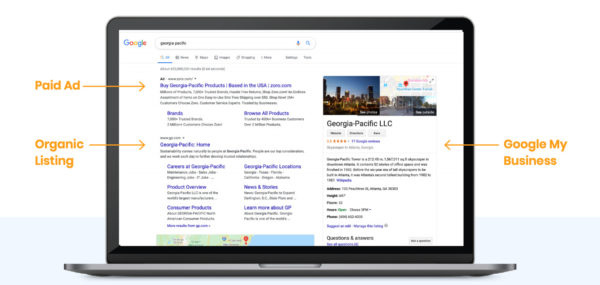
An effective marketing strategy for manufacturers has several key components:
- A well-designed, mobile-responsive website.
- Email campaigns that connect.
- A social media presence that’s proactive and informative.
- Reviews that are positive. Listings that are well-maintained and up-to-date.
- Content that’s well-written and dynamic, including social posts, blog posts, and white papers.
These are all the foundational elements of a successful manufacturing digital marketing plan.
What’s next is taking these efforts and making the right choices to further amplify them, increasing your return on investment (ROI). It used to be enough to just be visible, but the online landscape has changed over the past decade. Being visible is no longer enough. You have to stand out and be memorable to be found in the crowded online marketplace.
That’s where paid advertising comes in.
The fact of the matter is that in many cases, you’ll have to pay to reach people. It’s not a bad thing. It’s just something that has to be done in a smart way.
Read on to find out how to approach paid advertising for manufacturers in a way that returns actual value for your business.
Ready to get new manufacturing deals and repeat business — all in one place?
What is paid advertising for manufacturers?
Paid advertising for manufacturers is any variety of advertising that you pay for. It’s like paying rent to a company like Google or Facebook for valued ad space on their platform.
There are three main varieties of paid advertising: PPC, PPI, and display ads.
- PPC is pay-per-click, where you only pay each time one of your ads are clicked on.
- PPI is pay-per-impression, where you pay for each 1,000 impressions (views) your ad receives.
- Display ads are the more visual cousin of PPC and PPI paid ads. PPC and PPI ads are typically text-based. Display ads involve visual elements like illustrations or photos. These types of ads are also frequently referred to as banner ads.
What websites are best for manufacturers looking to invest in paid advertising?
You can buy ad space on a number of different platforms websites, but there are only two that we’re going to recommend for manufacturers to start with: Google and LinkedIn
Google is going to be your main focus when it comes to all varieties of paid advertising. Google Ads is the cornerstone of all modern paid advertising. It’s what everyone starts with and what everyone uses.

Google is the most widely used search engine, which means having your ads appear on its results pages will give you the most likely chance of conversion. It will seem confusing at first, like all new things, but there’s a ton of training available out there. In fact, you can find a tutorial on how to craft a Google ad right within on Constant Contact.
Historically, sales in the industrial and manufacturing spaces have been reliant on connections and word-of-mouth. That’s why using LinkedIn in conjunction with Google can be a successful B2B paid advertising plan. You can use Google Adsto draw in keyword-related traffic and LinkedIn to engage more socially.
LinkedIn ads allow you to target users by industry, company, and job title. If you’ve done work to develop an existing ICP or client personas, their ads give you an opportunity to really fine-tune who you’re reaching out to.
How much should you spend on paid advertising?
There is never going to be one singular, catch-all rule when it comes to how much to spend on ads. You’ll have to make changes based on your company’s existing needs, wants, and marketing budget. But just because there’s no golden ticket, doesn’t mean there aren’t general rules you can follow for the best potential ROI.
When you’re first getting started, try to set aside $1,500– $2,000 for testing. For manufacturers just beginning their Google Ads efforts, you’ll need to set your first month’s budget somewhere between $1,500 and $2,000, or about $50–65 per day.
This is a reasonably substantial investment, but it’s for good reason. Take into account the average lifetime value of a new customer.
Google’s conservative estimate is that advertisers earn $8 for every $1 they spend on ads. That’s not a guarantee, of course, as getting the most bang for your Google Ads buck depends on a number of factors, including how you set up your ads, how you choose target keywords, how crowded your market is, and how your direct competitors are using Google Ads.
By investing the suggested amount, you’ll be able to get a sufficient baseline test of which keywords drive the most traffic and conversions. As you experiment and learn more about which ads generate the best results, you can adjust your budget accordingly.
As you learn what does and doesn’t work, you can invest more money in the ads that are working to bring you more business.
Where should I start with paid advertising for my manufacturing business?
You’ve already started! You read this blog post, after all. To dig further into using paid advertising and other digital marketing tactics to benefit your business, I recommend checking out The Download: Making Sense of Online Marketing for Manufacturers. It’s a Constant Contact guide to everything you need to know on the topic — all in one understandable, easy-to-follow package.
Get Our Free Marketing Guide for Manufacturing
Our comprehensive guide to online marketing is packed with accessible, practical tips to help you get more leads and grow your business.




